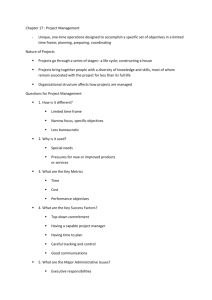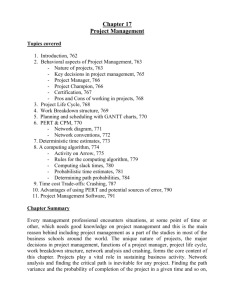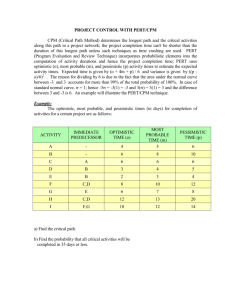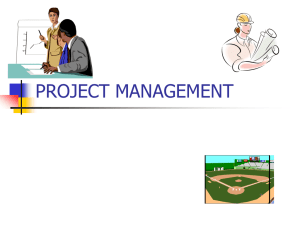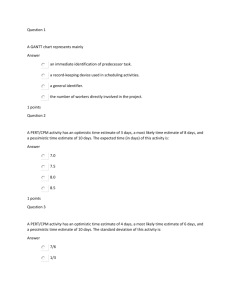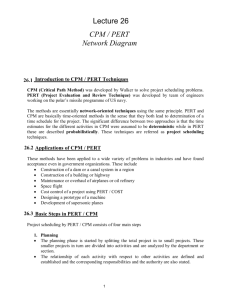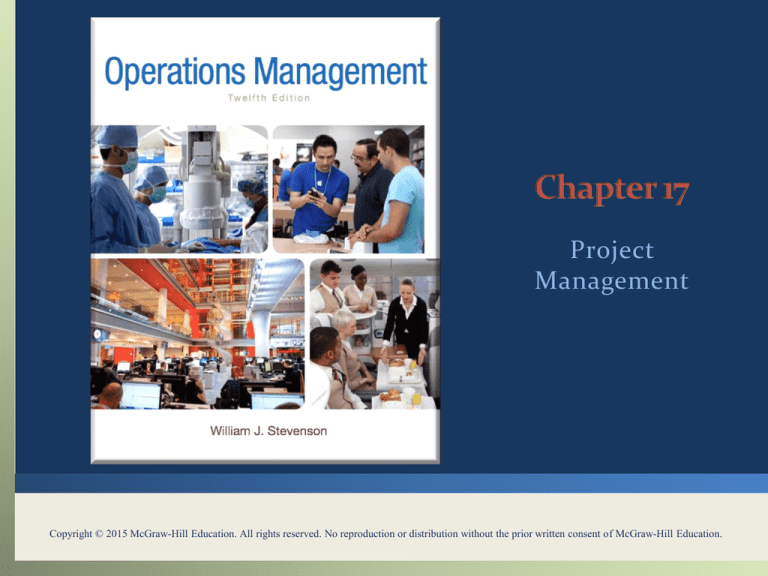
Project
Management
Copyright © 2015 McGraw-Hill Education. All rights reserved. No reproduction or distribution without the prior written consent of McGraw-Hill Education.
You should be able to:
LO 17.1
LO 17.2
Describe the project life cycle
Discuss the behavioral aspects of projects in terms of project
personnel and the project manager
LO 17.3 Explain the nature and importance of a work breakdown structure
in project management
LO 17.4 Name the six key decisions in project management
LO 17.5 Give a general description of PERT/CPM techniques
LO 17.6 Construct simple network diagrams
LO 17.7 Analyze networks with deterministic times
LO 17.8 Analyze networks with probabilistic times
LO 17.9 Describe activity ‘crashing’ and solve typical problems
LO 17.10 Discuss the advantages of using PERT and potential sources of
error
LO 17.11 Discuss the key steps in risk management
17-2
1.
2.
3.
4.
5.
Initiating
Planning
Executing
Monitoring and Controlling
Closing
LO 17.1
17-3
Behavioral problems can be created or exacerbated by
Decentralized decision making
Stress of achieving project milestones on time and within budget
Surprises
The team must be able to function as a unit
Interpersonal and coping skills are very important
Conflict resolution and negotiation can be an important part of a
project manager’s job
LO 17.2
17-4
WBS
A hierarchical listing of what must be done during a
project
Establishes a logical framework for identifying the required
activities for the project
1.
2.
3.
LO 17.3
Identify the major elements of the project
Identify the major supporting activities for each of the
major elements
Break down each major supporting activity into a list of the
activities that will be needed to accomplish it
17-5
Project success depends upon making key
managerial decisions over a sequence of steps:
Deciding which projects to implement
Selecting the project manager
Selecting the project team
Planning and designing the project
Managing and controlling project resources
Deciding if and when a project should be terminated
LO 17.4
17-6
PERT (program evaluation and review technique) and
CPM (critical path method) are two techniques used
to manage large-scale projects
By using PERT or CPM Managers can obtain:
1.
2.
3.
4.
LO 17.5
A graphical display of project activities
An estimate of how long the project will take
An indication of which activities are most critical to timely project
completion
An indication of how long any activity can be delayed without
delaying the project
17-7
Network diagram
Diagram of project activities that shows sequential relationships by
use of arrows and nodes
Activity on arrow (AOA)
Network diagram convention in which arrows designate
activities
Activity on node (AON)
Network convention in which nodes designate activities
Activities
Project steps that consume resources and/or time
Events
The starting and finishing of activities
LO 17.6
17-8
Finding ES and EF involves a forward pass through
the network diagram
Early start (ES)
The earliest time an activity can start
Assumes all preceding activities start as early as possible
For nodes with one entering arrow
ES = EF of the entering arrow
For activities leaving nodes with multiple entering arrows
ES = the largest of the largest entering EF
Early finish (EF)
The earliest time an activity can finish
EF = ES + t
LO 17.7
17-9
Finding LS and LF involves a backward pass through
the network diagram
Late Start (LS)
The latest time the activity can start and not delay the project
The latest starting time for each activity is equal to its latest finishing time
minus its expected duration:
LS = LF - t
Late Finish (LF)
The latest time the activity can finish and not delay the project
For nodes with one leaving arrow, LF for nodes entering that node equals the
LS of the leaving arrow
For nodes with multiple leaving arrows, LF for arrows entering node equals
the smallest of the leaving arrows
LO 17.7
17-10
Slack can be computed one of two ways:
Slack = LS – ES
Slack = LF – EF
Critical path
The critical path is indicated by the activities with zero
slack
LO 17.7
17-11
The beta distribution is generally used to describe the
inherent variability in time estimates
The probabilistic approach involves three time
estimates:
Optimistic time, (to)
The length of time required under optimal conditions
Pessimistic time, (tp)
The length of time required under the worst conditions
Most likely time, (tm)
The most probable length of time required
LO 17.8
17-12
Crashing
Shortening activity durations
Typically, involves the use of additional funds to support additional
personnel or more efficient equipment, and the relaxing of some work
specifications
The project duration may be shortened by increasing direct
expenses, thereby realizing savings in
indirect project costs
LO 17.9
17-13
Among the most useful features of PERT:
1. It forces the manager to organize and quantify available
information and to identify where additional
information is needed
2. It provides the a graphic display of the project and its
major activities
3. It identifies
a. Activities that should be closely watched
b. Activities that have slack time
LO 17.10
17-14
Good risk management involves
Identifying as many risks as possible
Analyzing and assessing those risks
Working to minimize the probability of their occurrence
Establishing contingency plans and budgets for dealing
with any that do occur
LO 17.11
17-15



